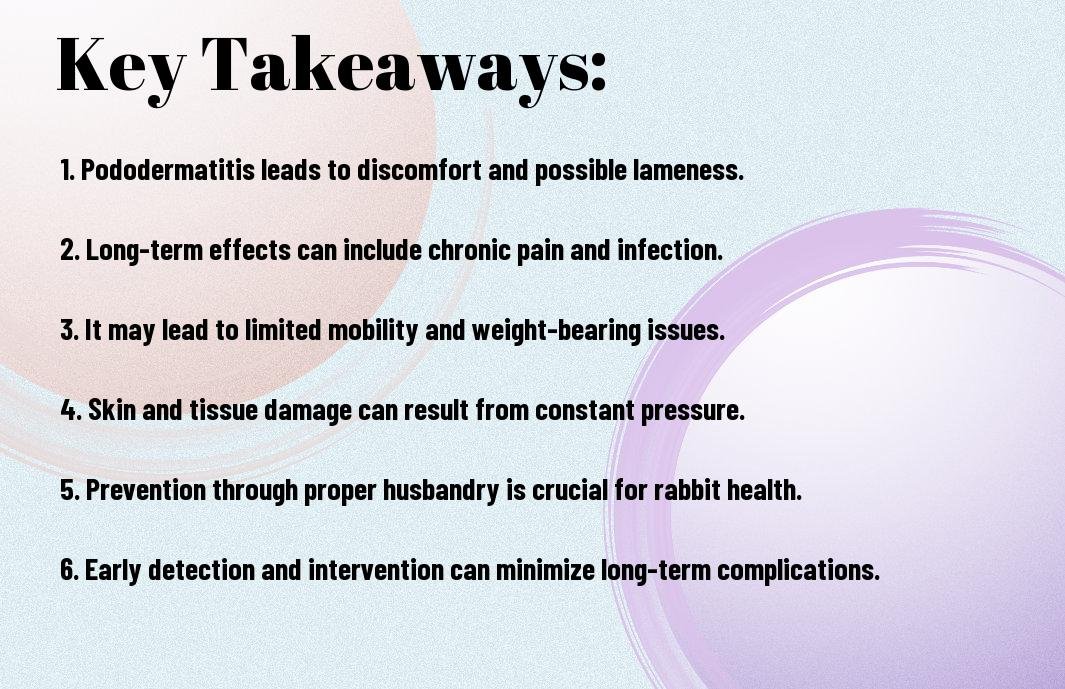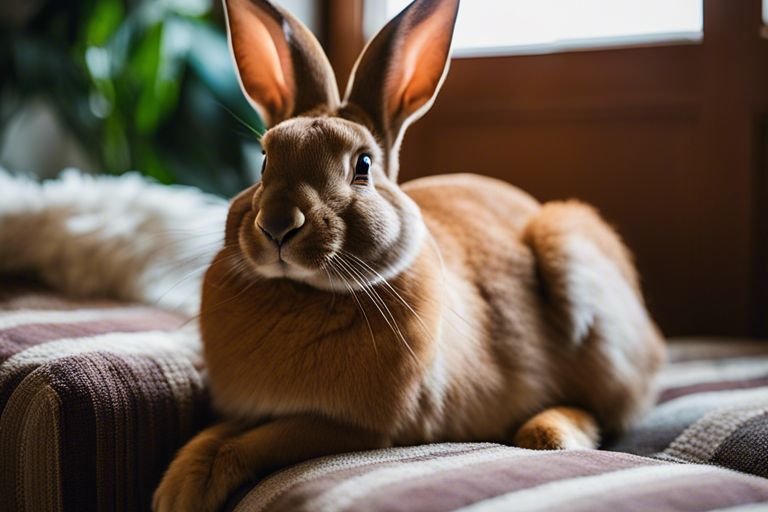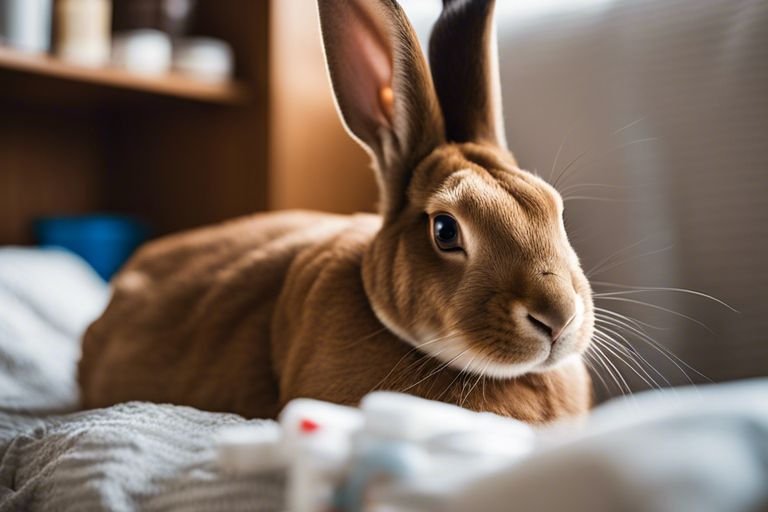Palmar pododermatitis, commonly known as sore hocks, affects the bottoms of your Flemish Giant rabbit’s feet and can lead to infection, pain, and discomfort. If left untreated, this condition can have serious long-term effects on your rabbit’s health and well-being. In this blog post, we will discuss the potential consequences of paw pododermatitis in Flemish Giant rabbits and how to prevent and manage this condition to ensure the happiness and health of your beloved pet.
Key Takeaways:
- Paw Pododermatitis can have serious long-term effects on Flemish Giant rabbits, leading to pain, discomfort, and mobility issues.
- Chronic infection and inflammation of the paw pads can lead to irreversible damage and scarring, affecting the rabbit’s ability to walk and hop normally.
- Untreated Paw Pododermatitis can also increase the risk of secondary infections and abscesses, further compromising the rabbit’s health and well-being.
- Proper husbandry and regular veterinary care are critical in preventing and managing Paw Pododermatitis in Flemish Giant rabbits.
- Early intervention and ongoing treatment can help minimize the long-term effects of Paw Pododermatitis and improve the rabbit’s quality of life.

Understanding Paw Pododermatitis
Some rabbit breeds, especially large ones like the Flemish Giant, are prone to a condition called paw pododermatitis. Also known as sore hocks, this condition affects the rabbit’s feet and can lead to long-term discomfort and health issues if not properly treated. Understanding the causes and risk factors specific to Flemish Giant rabbits can help you identify and prevent paw pododermatitis in your pet.
Definition and Pathophysiology
Paw pododermatitis is a painful condition that affects the feet of rabbits. It is characterized by inflammation, sores, and calluses on the bottom of the feet. The constant pressure on the feet, especially in larger breeds like the Flemish Giant, can lead to tissue damage and infection, resulting in discomfort and lameness.
Causes and Risk Factors Specific to Flemish Giant Rabbits
There are several factors that can contribute to the development of paw pododermatitis in Flemish Giant rabbits. These include excessive body weight, poor flooring in their environment, and lack of exercise. Additionally, genetic predisposition and poor grooming habits can also play a role. Assume that these factors put your Flemish Giant rabbit at a higher risk for paw pododermatitis, and take proactive measures to prevent it.
Long-term Effects of Pododermatitis
Pododermatitis, also known as sore hocks, is a common condition in Flemish Giant rabbits that can have long-term effects on their physical and emotional well-being. While the condition itself may be treatable, it is important to consider the lasting effects it may have on your rabbit’s overall health and quality of life.
Lastly, it is important to be aware of the potential long-term effects of pododermatitis on your Flemish Giant rabbit. This condition can lead to chronic pain, discomfort, and difficulty in movement, which can impact your rabbit’s physical health, behavior, and overall quality of life.
Physical Health Implications for Flemish Giant Rabbits
Pododermatitis can have significant physical health implications for Flemish Giant rabbits. Chronic pressure sores can lead to infections, abscesses, and even osteomyelitis. These conditions can be painful and difficult to treat, and may require long-term care and medical management. Additionally, the damage to the skin and tissues on the feet can lead to changes in gait and posture, further impacting your rabbit’s physical well-being.
Behavior and Quality of Life Impact
The long-term effects of pododermatitis can also impact your rabbit’s behavior and overall quality of life. Chronic pain and discomfort can lead to changes in behavior, including irritability, decreased activity levels, and even refusal to move. This can not only affect your rabbit’s well-being, but also your bond with them. Additionally, your rabbit may experience emotional distress and a decreased quality of life as a result of the ongoing discomfort and limitations in mobility.
Management and Prevention Strategies
After diagnosing your Flemish Giant rabbit with paw pododermatitis, it is essential to implement proper management and prevention strategies to ensure the well-being of your pet. This will involve a combination of current treatment options, preventative measures, and regular monitoring to ensure the condition does not worsen. By taking proactive steps, you can effectively manage this condition and prevent it from recurring in the future.
Current Treatment Options for Pododermatitis
When it comes to managing pododermatitis in your Flemish Giant rabbit, it’s crucial to work with your veterinarian to develop a treatment plan. This may include the use of topical ointments, antibiotics, and pain management medications to address any discomfort your rabbit may be experiencing. In severe cases, surgical intervention may be necessary to remove necrotic tissue and promote healing. It is important to follow your veterinarian’s recommendations closely and administer any prescribed medications as instructed to ensure the best possible outcome for your rabbit.
Preventative Measures for Flemish Giant Rabbits
Preventing pododermatitis in Flemish Giant rabbits requires a proactive approach to husbandry and habitat management. You can start by providing appropriate flooring in your rabbit’s living area, such as soft bedding or padding, to reduce the pressure on their feet. Regularly inspect your rabbit’s feet for any signs of redness or inflammation, and keep their living area clean and dry to prevent the development of bacterial or fungal infections. Additionally, ensuring your rabbit maintains a healthy body condition and proper grooming practices can also play a role in preventing pododermatitis. By implementing these preventative measures, you can significantly reduce the risk of your rabbit developing this painful condition.

Conclusion
So, it is important to be aware of the long-term effects of paw pododermatitis in your Flemish Giant rabbit. This condition can lead to chronic pain, lameness, and even deformities in the feet if left untreated. It is essential to provide proper flooring, regular exercise, and prompt treatment for any signs of pododermatitis to prevent long-term complications for your beloved pet. Always consult with your veterinarian for the best care and management of this condition to ensure the health and well-being of your rabbit.
FAQ
Q: What are the long-term effects of paw pododermatitis in Flemish Giant rabbits?
A: Paw pododermatitis, also known as sore hock, can have several long-term effects on Flemish Giant rabbits. These effects can include chronic pain, difficulty in movement, and a decreased quality of life. If left untreated, the condition can lead to serious infections and debilitation.
Q: How can paw pododermatitis be prevented in Flemish Giant rabbits?
A: Preventing paw pododermatitis in Flemish Giant rabbits involves providing proper housing and flooring. Ensure that the rabbit’s living space is clean, dry, and spacious enough to allow for natural movement. Additionally, providing a soft and comfortable resting surface, such as a padded mat or bedding, can help prevent the development of paw pododermatitis.
Q: What treatment options are available for Flemish Giant rabbits with paw pododermatitis?
A: Treatment for paw pododermatitis in Flemish Giant rabbits may include veterinary care, wound care, pain management, and environmental modifications. This can involve cleaning and dressing the affected paws, administering pain medication, and implementing changes to the rabbit’s environment to alleviate pressure on the affected areas. In severe cases, surgical intervention may be necessary.
